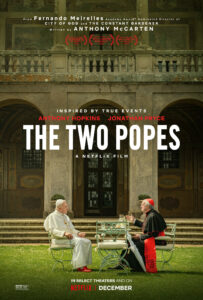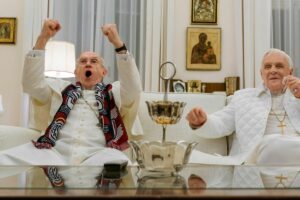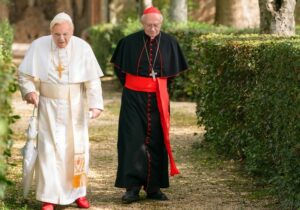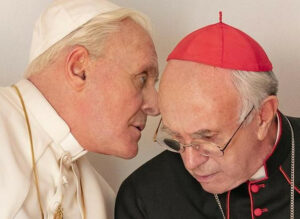“The Two Popes” – Faith in the Face of Doubt

Title: “The Two Popes”
Release Date: 2019
Director: Fernando Meirelles
Cast: Anthony Hopkins, Jonathan Pryce, Juan Minujin, Luis Gnecco, Cristina Banegas
“The Two Popes” is a well acted and precisely thought out film. Its main idea is to build the world presented on the basis of opposition. However, the differences turn out to be illusory – on a deeper level they are like two sides of the same coin. Two radically different personalities and two doctrinal visions are as complementary to each other as faith, which, as the film shows, needs constant doubt in order to stay alive.
“The Two Popes” – European intellectualism versus Ibero-American temperament
The movie “The Two Popes” shows the genesis of the current situation in the Catholic Church, namely the fact that it is headed by two leaders at the same time: retired Holy Father Benedict XVI and Pope Francis. The picture shows an interesting clash of these two different men, who go from initial mutual dislike and significant differences in worldview to friendship and mutual understanding. This happens during one significant meeting, which changes their personal fates, but also the history of Western Christianity.
The film’s protagonists were constructed on the basis of contrasts: of personalities, but also of cultures, and even representations of radically different tendencies within the doctrine of Christianity. Such a juxtaposition had a great effect, as next to serious issues and problems it introduced a light, almost comedic convention. Importantly, this domination of the genre does not diminish the importance of the characters, but pulls them down from their monumental pedestal and shows their most human face.

Benedict XVI is particularly attractive in “The Two Popes” thanks to the phenomenal performance of Anthony Hopkins. He managed to play the role of the retired bishop of Rome so perfectly that you do not even for a moment feel that you are dealing with an actor’s performance. Cardinal Ratzinger in this version is an almost fascinating character, full of contradictions: on the one hand, he is characterized by a cool reserve and scientific intellectualism, on the other hand, he has a remarkable sense of humor (although he claims to be completely devoid of it) and a weakness for popular television series. In this sense the film warms up the image of the pope-emeritus, who appears in the public consciousness in a completely different way.
Benedict XVI is also a representative of the old European elite – educated and conservative. He is a lover of music and art – he plays the piano wonderfully and reveals that in his youth he had ambitions to be a composer. At the same time, the film clearly emphasizes that he is a man of a previous era. This is evident in a significant scene at the piano, when the protagonist recalls with nostalgia a well-known pre-war German artist.
A worthy adversary of Pope Benedict in “The Two Popes” is Cardinal Bergoglio, played by Jonathan Pryce. Cardinal Bergoglio is a flesh and blood Argentinean, a soccer and tango enthusiast. Pryce’s character is given much more space in the film, as numerous scenes from his youth and difficult priestly path are shown. Bergoglio is a man of the new era – symbolized by his fluent knowledge of pop culture icons like the legendary Beatles, about whom he seems to know everything. Unlike Benedict XVI, the future Pope Francis uses a simple language of emotion, stemming from his close relationship with people and his extraordinary modesty. Bergoglio doesn’t look at the world from behind the window of an exclusive limousine, but from the confines of a city bus.

“The Two Popes” – two visions of the Church
The personal and cultural differences between the protagonists of “The Two Popes” also translate into doctrinal differences between Benedict XVI and Francis. Although this issue does not play a major role in the film, it is clearly hinted at. We also have to admit that we are dealing here with certain simplifications which are supposed to be understandable for the viewers without entering into the theological complexities.
Benedict is therefore a representative of the conservative Church, closed to such sensitive issues as contraception, abortion, non-sacramental relationships or homosexuality, and what is more, entangled in pedophile scandals. Bergoglio seems to be a great reformer: he gives holy communion to divorcees and does not condemn gays and lesbians. One cannot help but ask, however, whether this contrast is not a bit exaggerated and whether Cardinal Bergoglio, as Pope Francis, will really make a breakthrough in these areas or whether they will remain in the state of declarations and documents that do not have a binding effect on all episcopates in the world.
“The Two Popes” – one man and one God
For me, nonetheless, the greatest value of the movie “The Two Popes” is the fact that this psychomachy constantly surprises, and the directions taken by the characters are perversely complicated. The bishops of Rome are portrayed as ordinary people who, like everyone else, experience serious difficulties in their faith. As Cardinal Bergoglio says, the voice of God is like the signal from a satellite dish – sometimes it receives perfectly, and sometimes it completely loses the transmission.

Interestingly, there is some mysterious symmetry here between the characters’ personal beliefs about what the Creator expects of them and his actual plans, as in Christ’s biblical maxim: “My thoughts are not your thoughts, and my ways are not your ways.” And so Bergoglio receives a priestly vocation, on the evening of his engagement to his beloved girlfriend, and Benedict XVI, the conservative voice of the Church, sees an opportunity for its renewal in the different outlook of the revolutionary bishop from Argentina. The leitmotif underlining this misreading of divine intentions is the twice-cited story of St. Francis, who, hearing the command to rebuild the temple, initially takes it literally and begins to build a structure of bricks.
The most moving passages, however, are the pearls, when their authentic doubts emerge from behind the dispute of the two great clerics. These are the moments when they do not hear the voice of God at all, and everything seems hazy – there is no clear path to follow. There is no sign, there is silence, loneliness and darkness. And it is this human doubt, this uncertainty about one’s own infallibility, that most closely connects the two figures discussing in the Sistine Chapel beneath Michelangelo’s fresco depicting the creation of man.
That’s why, while watching “The Two Popes”, I thought of the writings of Tomáš Halik, a Czech clergyman who, during the pontificate of John Paul II, was consul of the Pontifical Council for Dialogue with Unbelievers. I had in my mind his book What Is Not Shaky, Is Impermanent, in which the priest emphasizes that faith cannot exist without doubt, and that the moment when everything becomes obvious and certain is paradoxically a moment of spiritual stagnation. In the Netflix film, Francis embodies these doubts of Benedict, while Ratzinger is a symbol of the questioning voice in Bergoglio’s mind. Halik’s words, then, in some sense may sum up the film’s intent: “I learned to live in a double world of skepticism and trust; I became a question for myself. [God], my hope and my rock, remains present in me above all in the form of an enduring question. The question with which I ask about God and the question which God asks me are the same question.”
